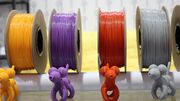3D printing filaments
Jump to navigation
Jump to search
Description
Thermoplastic feedstock used by fused deposition 3D printers to create a finished product. 3D printing filaments are available in a multitude of compositions and colors. Pigments or other additives are added to the material before it is melted to create colored filament or filament with special properties, e.g. increased strength or magnetic properties.
The process of transforming 3D printing filament into a 3D model
- The filament is fed into the FDM 3D printer.
- The thermoplastic is heated past its glass transition temperature inside the hotend.
- The filament is extruded and deposited by an extrusion head onto a build platform where it cools.
- The process is continuous, building up layers to create the model.
Comparison Table
| Filament Type | Pros | Cons | Print Temperature | Common Applications | Recorded tests Brand name: number (dates) See note below. |
|---|---|---|---|---|---|
| PLA (Polylactic Acid) | Easy to print, low temperature, good surface finish, low odor, biodegradable | Brittle, low heat resistance, can warp | 180-230 C | Prototyping, decorative objects, toys, temporary surgical implants | |
| ABS (Acrylonitrile Butadiene Styrene) | Strong, durable, high temperature resistance, good for functional parts, inexpensive | Prone to warping, requires heated bed, strong odor, non-biodegradable | 210-250 C | Functional parts, mechanical parts, enclosures | * Imaterialise: 1(2019) |
| PET or PETG (Polyester, Polyester terephthalate glycol) | High strength and durability, flexible, recyclable, most commonly used, low odor, does not shrink or warp | Can be scratched easily, can absorb moisture, not easy to print | 210-235 C | Almost anything, Food containers (select grades are food safe), bottles, mechanical parts | * Verbatim: 1(2018) * Keene Village Plastics: 1(2020) |
| Nylon (Polyamide) | Very strong and durable, flexible, abrasion resistant, high temp resistance | Absorbs moisture (proper storage needed), can be difficult to print, releases odor | 220-260 C | Functional parts, gears, bearings, tools | * Taulman Bridge: 1(2018) * Ultimaker: 4(2017-2018) * Imaterialise: 2(2019) * Shapeways 2(2019-2020) |
| PMMA (Acrylic) | Strong, durable and rigid; Transparent and impact resistant | 235-250 C | light diffusers | ||
| PP (Polypropylene) | Flexible, good chemical resistance | Difficult to print | 210-230 C | Flexible components | * Verbatim: 2(2018) * Tuscan Industries: 1(1997) |
| TPU (Thermoplastic Polyurethane) | Flexible, elastic, impact resistant, good for flexible parts | Can be difficult to print, requires specific settings | 225-235 C | Flexible parts, phone cases, gaskets, seals | * Carbon3d: 1(2018) * Keene Village Plastics: 1(2020) |
| PC (Polycarbonate) | Extremely strong and durable, high temperature resistance, impact resistant | Difficult to print, requires high temperature, prone to warping | 270-310 C | Functional parts, engineering prototypes, high-strength applications | |
| ASA (Acrylonitrile Styrene Acrylate) | UV resistant, weather resistant, strong, durable, good for outdoor use | Similar to ABS in printing difficulty, can have strong odor | 240-260 C | Outdoor parts, automotive parts, weather-resistant applications | |
| PEEK (Polyetheretherketone) | Extremely high temperature resistance, chemically resistant, very strong | Very expensive, very difficult to print, requires very high temperatures | High-performance applications, aerospace, medical implants | ||
| Carbon Fiber Filled PLA | Increased strength and stiffness, lightweight, improved dimensional stability | Can be abrasive (wear on nozzles), more expensive | 190-230 C | Structural parts, drones, robotics | |
| Wood Filled | Unique aesthetic, can be sanded and stained, gives a wood-like appearance | Can be brittle, more difficult to print than PLA, can absorb moisture | 200-260 C | Decorative objects, models, art projects | |
| Metal filled (PLA or ABS) | Realistic metal feel and weight, can be post-processed (e.g., polishing) | Can be abrasive, printing needs fine tuning, more expensive | 195-220 C | Decorative objects, models, tools, jewelry | * Shapeways: Aluminum (2017) * Shapeways: Stainless steel (2017) * Imaterialise: Alumide (2019) |
- Note: The AIC Materials Testing Results page provides information on Oddy tests that were completed on these materials. Access their database, then use the search box to locate materials of interest.
Risks
Working Properties
Forms and Sizes
- Common types are 1.75mm and 2.85mm
Resources and Citations
- 3D Insider: 16 Types of 3D Printing Materials accessed Feb 2025
- Wikipedia: [ https://en.wikipedia.org/wiki/3D_printing_filament 3d Printing Filament] accessed Feb 2025
